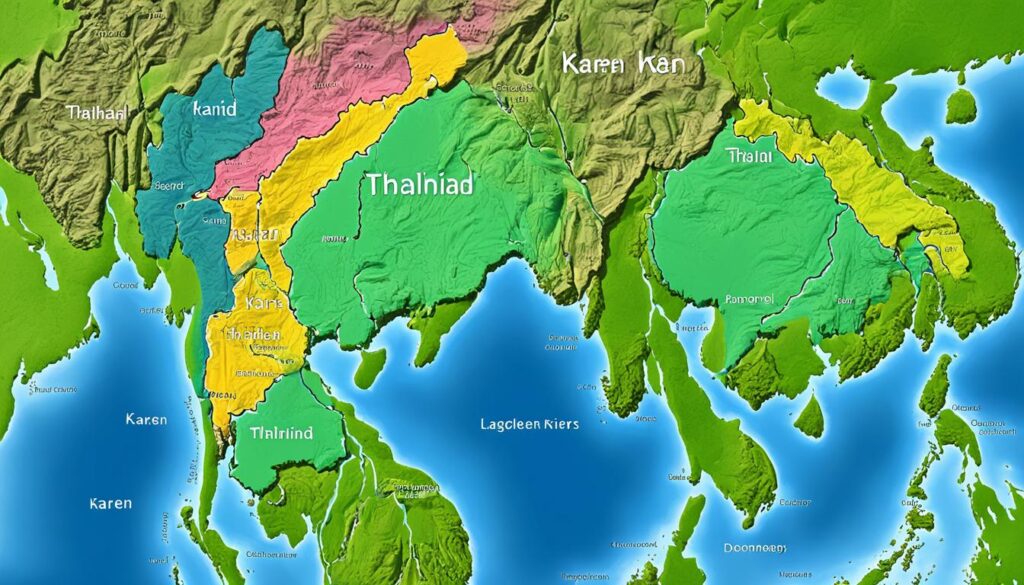Did you know that the Karen people, an ethnic group in Southeast Asia, have a language with over 4.5 million speakers? Meet the Karen language, a unique and captivating part of Karen culture. From its tonal nuances to its distinctive script, this language holds the key to understanding the rich heritage of the Karen community. Let’s delve into the depths of the Karen language and uncover its hidden treasures.
Karen Language Classification
The Karen languages belong to the Sino-Tibetan language family, specifically the Karenic branch of the Tibeto-Burman subfamily. However, the classification of the Karen languages is still a topic of debate among scholars. These languages are further subdivided into different groups based on geographical location and linguistic characteristics.
Some proposed classifications include Proto-Karenic, Brakaloungic, and Northern, Central, and Southern branches. These classifications help to better understand the diversity and relationships within the Karen language family.
“The Karen languages, as part of the Sino-Tibetan language family, have distinct characteristics that contribute to their classification within the Karenic branch of the Tibeto-Burman subfamily.” – Linguistics expert
The classification of the Karen languages plays a crucial role in studying their history, evolution, and linguistic connections. It helps linguists and researchers gain insights into the development and distribution of the Karen languages across different regions.
Proto-Karenic
Proto-Karenic is a proposed classification that aims to establish a common ancestral language from which the Karenic languages have evolved. It serves as a foundation to study the linguistic features, phonology, and grammar shared by various Karenic languages.
Brakaloungic
The Brakaloungic branch refers to a group of Karen languages spoken in the southern region of Myanmar. These languages exhibit distinct features that differentiate them from other Karenic languages.
Northern, Central, and Southern branches
Another classification divides the Karen languages into three broad branches based on their geographical distribution: Northern, Central, and Southern branches. Each branch includes several distinct Karen languages spoken in specific regions.
The classification of the Karen languages not only helps in understanding their linguistic diversity but also sheds light on the cultural and historical context in which these languages have developed and evolved.
| Classification | Description |
|---|---|
| Proto-Karenic | Proposed ancestral language of the Karenic branch |
| Brakaloungic | Group of Karen languages spoken in southern Myanmar |
| Northern, Central, and Southern branches | Geographically differentiated branches of Karen languages |
Understanding the Karen language classification provides valuable insights into the relationships between different Karen languages, their shared features, and their distinct characteristics. This knowledge aids in the preservation, study, and appreciation of the rich linguistic heritage of the Karen people.
Karen Language Varieties
The Karen language is incredibly diverse, with several distinct varieties spoken by different populations within the Karen ethnic group. These varieties include:
- Sgaw Karen: Sgaw Karen, also known as Karen, is the most widely spoken variety of the Karen language. It is spoken by a significant number of Karen people and serves as a language of education and literature for the community.
- Pwo Karen: Pwo Karen is another major variety of the Karen language. It is spoken by a significant number of Karen people and has its own unique features and characteristics.
- Kayan (Padaung): Kayan, also known as Padaung, is a branch of the Karenic language family. It is spoken by the Kayan people, who are known for their distinctive “long neck” tradition.
- Karenni: Karenni is another branch of the Karenic language family. It is spoken by the Karenni people, also known as the Red Karen or Kayah people. Karenni has its own linguistic features and is an important part of the Karenni cultural identity.
Each of these varieties has its own unique linguistic features, dialectal differences, and cultural significance within the Karen community.
| Variety | Spoken By | Unique Features |
|---|---|---|
| Sgaw Karen | Widely spoken by Karen people | Largest variety with strong literary tradition |
| Pwo Karen | Karen people | Distinctive pronunciation and vocabulary |
| Kayan (Padaung) | Kayan people | Part of the Karenic language family, with its own unique characteristics |
| Karenni | Karenni people | Branch of the Karenic language family, important for Karenni cultural identity |

Karen Language Writing System
The Karen languages have a unique writing system known as the Karen script, which plays a significant role in preserving and promoting the language and culture. Developed in the 19th century by an American Baptist missionary, the Karen script is based on the Burmese alphabet, with additional characters and modifications to represent Karen phonetics.
The Karen script is primarily used for educational and cultural purposes, allowing Karen people to write and read in their own language. It has been instrumental in documenting Karen traditions, folklore, and historical accounts, serving as a valuable resource for future generations.
However, the use of the Karen script has faced challenges in recent years due to increased exposure to other languages and writing systems. As Karen communities interact more with the broader society, there has been a gradual shift towards using alternative scripts such as the Burmese script or the Latin alphabet for practical purposes.
“The Karen script is not only a writing system but also an integral part of our cultural heritage. It connects us to our roots and allows us to express ourselves in a way that resonates with our identity as the Karen people.” – Nang Noom, a Karen language advocate.
Despite the declining use of the Karen script, efforts are being made to revitalize and promote its usage. Language preservation initiatives, community-based education programs, and the development of digital resources have been effective in encouraging the younger generation to learn and appreciate the Karen script.
| Advantages of the Karen Script | Challenges Facing the Karen Script |
|---|---|
|
|
Karen Language Speakers and Distribution
The Karen languages are spoken by approximately 4.5 million Karen people, primarily in southeastern Myanmar (Burma) and western Thailand. The Karen people, an ethnic group with a rich cultural heritage, hold their language in high regard, as it plays a significant role in their community and identity.
The geographic distribution of the Karen languages is influenced by a combination of historical and political factors, as well as the migration patterns of the Karen people. Over the years, the Karen community has experienced displacement due to armed conflict and political unrest in their homeland.
“Our language is a crucial part of our identity and a way for us to preserve our heritage,” says Nang Seng, a Karen language teacher. “We take great pride in passing down our language to future generations, despite the challenges we face.”
“Language is the thread that weaves the fabric of our community together,” says Saw Eh Wah, a Karen community leader. “It connects us to our ancestors and helps us maintain a sense of belonging, even when we are far from our homeland.”
The Karen people have a strong sense of solidarity and resilience, which is reflected in their efforts to preserve and promote their language. Community organizations and educational institutions have been instrumental in providing language learning opportunities for both children and adults.
“Learning our language is not only about communication, but also about understanding our culture and connecting with our roots,” says Naw Mu Plah, a Karen language learner. “It gives me a sense of pride and a deeper connection to my community.”

Karen Language and Culture
The Karen language is an integral part of the Karen culture. It serves not only as a means of communication but also as a reflection of the Karen people’s identity, history, and traditions. Through the language, the Karen community engages in various cultural practices, including traditional ceremonies, storytelling, and songs, preserving and transmitting their rich cultural heritage.
“Our language is the key to unlocking the stories of our ancestors and the wisdom they have passed down to us. It connects us to our roots and helps us understand who we are as a people.”
– Karen elder
The Karen language and culture are closely intertwined, with each influencing and shaping the other. It is through the language that the Karen people express their values, beliefs, and worldview, reinforcing a strong sense of community and belonging. From the rhythmic melodies of traditional songs to the eloquent words spoken during ceremonies, the language serves as a powerful expression of Karen cultural identity.
Traditional Karen ceremonies often feature traditional dances and songs performed in the Karen language. These cultural practices play a vital role in preserving the Karen heritage and passing it down to future generations. Through the language, stories of triumph, resilience, and love are shared, connecting the past with the present and guiding the Karen people towards a bright future.
Conclusion
The Karen language holds great significance as a cornerstone of the Karen people’s cultural heritage and identity. As a unique language within the Sino-Tibetan language family, it stands out with its distinctive script, diverse varieties, and widespread distribution. Despite the challenges faced in preserving and promoting the language, the Karen community continues to cherish and uphold their linguistic and cultural traditions.
Throughout generations, the Karen language has played a pivotal role in strengthening the bond among the Karen people. It serves as a powerful tool to maintain their rich cultural traditions, fostering a sense of unity and belonging within the community. The language is deeply intertwined with Karen ceremonies, storytelling, and songs, contributing to the preservation of their collective heritage.
As the Karen people navigate a rapidly changing world, they remain committed to preserving their linguistic and cultural heritage. The Karen language stands as a testament to their resilience and determination to pass on their traditions to future generations. By continuing to promote and celebrate the Karen language, the community ensures that their unique identity and rich cultural legacy will endure.
FAQ
What is the Karen language?
The Karen language is a tonal language spoken by the Karen people in Thailand and Burma. It is part of the Sino-Tibetan language family and has three main branches: Sgaw Karen, Pwo Karen, and Pa’O.
How is the Karen language classified?
The Karen language is classified within the Sino-Tibetan language family, specifically the Karenic branch of the Tibeto-Burman subfamily. There is some debate about its exact classification.
What are the varieties of the Karen language?
The Karen language has several varieties, including Sgaw Karen, Pwo Karen, Kayan, and Karenni. Sgaw Karen and Pwo Karen are the most widely spoken varieties.
How is the Karen language traditionally written?
The Karen language is traditionally written using the Karen script, which was developed in the 19th century based on the Burmese alphabet.
How many people speak the Karen language and where is it spoken?
The Karen language is spoken by approximately 4.5 million Karen people and is primarily spoken in southeastern Myanmar (Burma) and western Thailand.
What is the role of the Karen language in the Karen culture?
The Karen language is an integral part of the Karen culture. It is not only a means of communication but also a reflection of the Karen people’s identity, history, and traditions. It plays a significant role in preserving and transmitting the cultural heritage of the Karen community.
Why is the Karen language important?
The Karen language is a vital aspect of the Karen people’s cultural heritage and identity. It plays a significant role in strengthening the Karen community and preserving their rich traditions for future generations.
